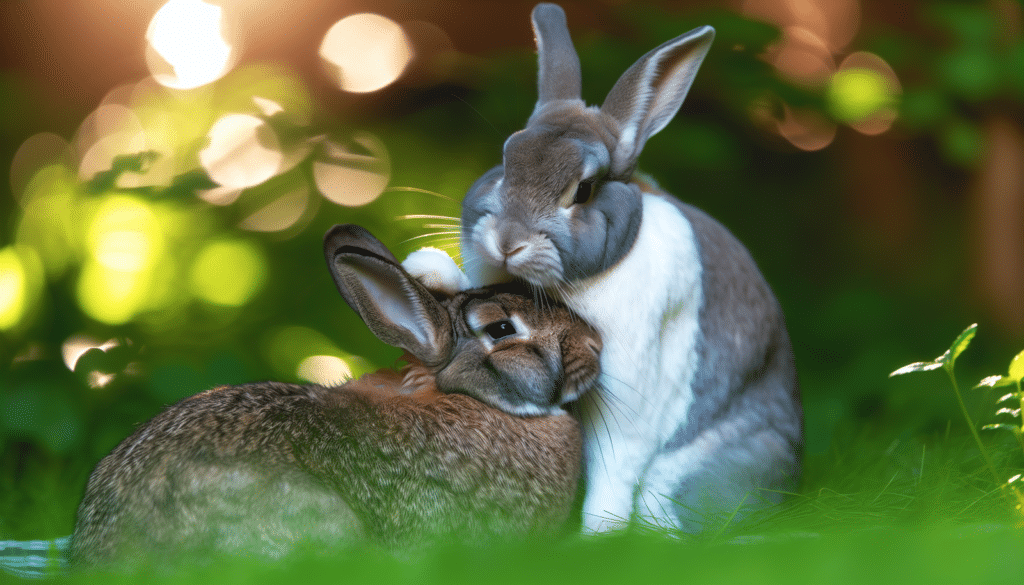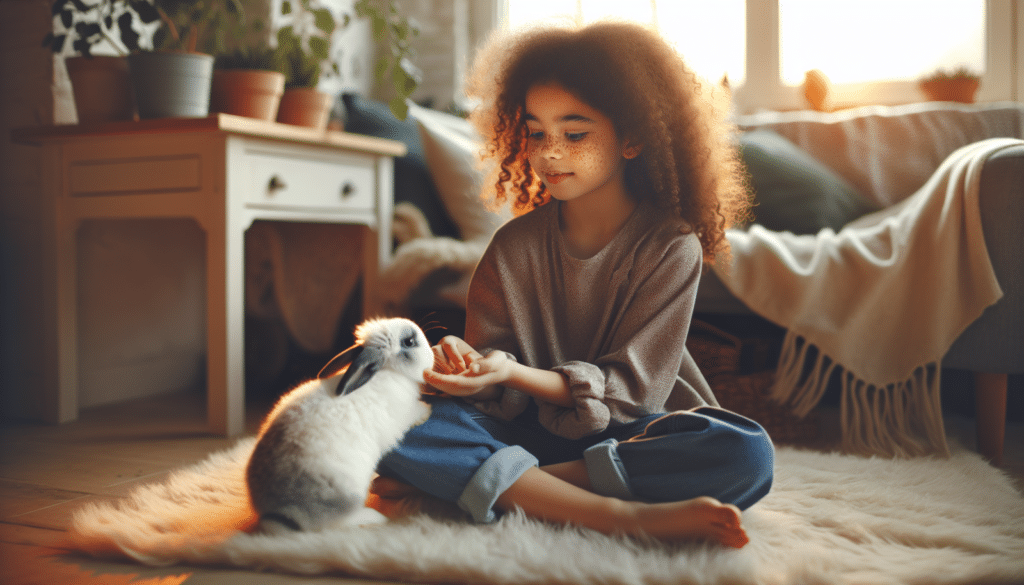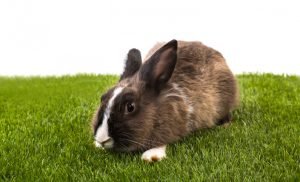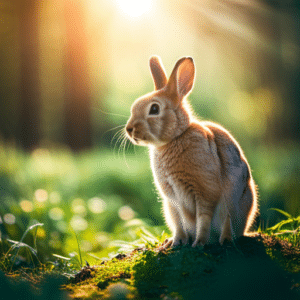Wondering if your rabbit is happy, scared, or asking for attention? Recognizing the subtleties of rabbit body language can transform your interactions with your furry companion. From ear twitches that signal curiosity to tail thumps indicating alarm, each gesture has a meaning. In this article, you’ll gain the tools to read these signals like an expert, enhancing your rabbit’s comfort and peace of mind.
Key Takeaways
Rabbit ears are more than hearing tools – they help convey emotions from happiness to stress, with different positions and movements like erect ears for alertness or flat ears for relaxation.
The position and movement of a rabbit’s tail are key indicators of their emotional state, with a puffed-up tail showing happiness and confidence, while a tucked tail suggests fear or insecurity.
Understanding rabbit postures and movements such as binkies for joy, flopping for contentment, or thumping for alarm can greatly enhance the pet-owner bond and improve rabbit care.
Rabbit Ears: Emotion Indicators

Have you ever noticed how your pet rabbit’s ears are constantly on the move, twitching and turning like little satellite dishes? That’s because rabbit ears are not just for hearing; they’re emotional barometers, giving us clues about what’s going on in that furry little head. Decoding the signals given by a rabbit’s ears allows for a deeper connection with your pet.
From alertness to relaxation, happiness to fear, a rabbit’s ears tell a story. They stand erect when your rabbit is curious or alert, and lay back flat when relaxed or stressed. Frequent twitching of their ears is an indication of anxiety or disturbance. So, next time you’re with your bunny, pay close attention to those ears, they’re telling you a tale!
Alert and Curious Ears
Imagine your rabbit sitting up, ears standing tall and rigid, like a furry little radar station. This is a classic sign of alertness, possibly due to an unfamiliar sound or a perceived threat. But don’t worry, it doesn’t necessarily mean danger. It could just be your bunny being curious about a new toy or the sound of a rustling treat bag!
At times, when their curiosity is cautious, rabbits may exhibit the following behaviors:
Their ears slant forward over their head
Increased nose twitching as they process new scents through their scent glands
Adopting a body stance with their tail and head stretched out, standing on all fours with a focused gaze in the direction of their interest
These behaviors indicate that the rabbit is expressing, “I’m not sure about this, but I’m interested!”
Relaxed and Stressed Ears
Now, if your bunny’s ears are lying back against their body, that’s a sign of relaxation and contentment. It’s as if they’re saying, “All’s well in bunny land.” This relaxed position often comes with a side of bunny bliss, where they lie down with their legs spread out in a comfortable position.
On the other hand, the rabbit’s ears lying down on their head slanted backward at a rigid angle, signify anger or aggression. This clearly indicates that something is amiss and they are not pleased about it, making it crucial to understand the language of rabbit ears.
But what about those times when your rabbit’s ears flick back and forth? That’s a sign of nervousness or agitation. This signals that your bunny is stressed or uncomfortable.
Recognizing these behavioral cues allows you to make necessary environmental adjustments for their comfort and happiness.
Painful Ear Twitches
Now, let’s talk about twitching ears. If your pet rabbit’s ears twitch repeatedly, it could mean they’re in pain or feeling discomfort. Perhaps they’re dealing with digestive problems or an illness. Sometimes, they’ll even shake their ears and start scratching at them if they’re uncomfortable. This could be a red flag for ear mites, especially if the behavior is repetitive.
What action should be taken if your rabbit’s ears are twitching or shaking continuously? It’s time to seek veterinary attention. This could indicate an infection or other medical issues requiring attention. After all, it’s better to be safe than sorry when it comes to our furry friends’ health.
Rabbit Tails: Emotional Expressions

While the ears are the rabbit’s emotional antennae, the tail is their emotional barometer. From happiness and confidence to fear and intimidation, the tail tells all. The position and movement of a rabbit’s tail can reveal much about their emotional state. A puffed-up tail, for instance, is a rabbit’s way of showing that they’re happy and confident. On the contrary, a tucked tail usually signifies fear or insecurity.
So, as a rabbit owner, observing and interpreting the positioning and movement of your rabbit’s tail can be a wonderful way to gauge their emotional state. Consider it as your personal mood indicator for your bunny!
Happy and Confident Tails
If your pet rabbit’s tail is puffed up, that’s a good sign. It’s a clear indication of happiness and confidence. It’s like their version of a cat’s purring or a dog’s wagging tail. Along with a puffed-up tail, you might also notice tail wagging. This is another sign of excitement, happiness, and contentment in rabbits.
Another cute behavior that indicates a happy rabbit is butt twitching, often seen when they’re munching on their favorite treat. So, if you notice your bunny’s tail puffing up or wagging, you’re doing something right. You’re doing a great job at making your bunny happy!
Fearful and Intimidated Tails
On the other end of the spectrum, a tucked tail in a rabbit signals fear, insecurity, or intimidation. It’s a clear indicator that your bunny is feeling threatened or scared. When a rabbit is cautious or lacks confidence, it may stretch its tail out long and point it down toward the ground, with its legs tucked. This is a sign of potential fear.
In addition to the tail, other body language cues, such as crouching close to the ground or laying flat with wide and rigid ears, also indicate fear in rabbits. These are all signs that your bunny might not be feeling safe and secure. As a pet owner, it’s important to acknowledge these signs and alleviate any stressors causing these fear-induced behaviors.
Alarm Signals: Thumping Tails
Have you ever heard your rabbit thump their tail? If so, you’ve experienced a rabbit’s alarm signal. Comparable to a dog’s bark or a meerkat’s warning screech, a rabbit’s thump serves as a warning sign of alarm, fear, or perceived threats. During a thump, a rabbit arches its back slightly and looks very alert, then uses one or both feet to hit the ground hard. Often, this rabbit thumps is coupled with other non-vocal signals like tail flicking as a danger warning to other rabbits.
So, what should you do if your rabbit starts thumping their tail? Initially, aim to identify any potential triggers inducing this behavior. It could be anything from unfamiliar scents to the presence of strangers. Remember, some rabbits are more sensitive to a wider range of triggers. Identifying your rabbit’s individual sensitivities aids in creating a more comforting environment for them.
Rabbit Postures and Movements: Communicating Feelings

Beyond ears and tails, rabbits use a wide array of postures and movements to express their feelings. From the joyous leaps and twists of binkies to the stretching out of contentment, every hop, twist, and turn has a meaning. Understanding common rabbit body language, as well as the subtleties of rabbit body language, can help you better connect with your furry friend and appreciate the nuances of their rabbit body language.
Let’s start with happiness. A rabbit hopping or dancing, racing around, or jumping on furniture are all signs of pure bunny joy. Conversely, a rabbit may convey fear and anxiety via thumping, coupled with a fidgety and alert posture when the rabbit stands.
Then there’s the blissful state of contentment indicated by a bunny flop, where the rabbit lies down and appears tired and satisfied. All these behaviors are part of the rich tapestry of rabbit communication.
Content and Relaxed Rabbits
When your rabbit is content and relaxed, you’ll notice some specific behaviors. They may lie down on their side, often referred to as ‘flopping’ or a ‘rabbit flop.’ This indicates an extreme level of comfort, signaling complete trust in the environment. Another sign of contentment and relaxation is when they lie down with their front paws pointing forward and rear legs stuck out sideways. It’s like they’re saying, “I’m totally relaxed.”
While in this state, rabbits may also engage in soft teeth grinding and karate-style paw flinging during grooming. These behaviors suggest that your rabbit is relaxed and indulging in self-maintenance. The message here is clear: “I feel safe and comfortable.”
Defensive and Submissive Rabbits
Defensive and submissive behaviors in rabbits often involve specific body postures. A defensive rabbit may sit up on their hind legs with its front paws raised and ears pointed upwards. This posture, often accompanied by growling, can signal aggression stemming from fear.
On the other hand, submissive rabbits, including female rabbits, may lie flat on the ground with wide and rigid ears along their back, indicating fear and a desire for submission. If your rabbit adopts this posture, they’re trying to go unnoticed, attempting to blend into their environment. They’re communicating, “I’m scared and prefer to be left alone.”
Playful Binkies
Now, let’s talk about one of the cutest rabbit behaviors – the binky. A binky is a rabbit’s expression of happiness and playfulness, typically performed when they are in a joyful and energetic state. In a binky, a rabbit:
Leaps into the air
Lifts all four paws off the ground
Twists its body mid-air
Lands back on the ground
It’s a sight to behold!
Sometimes, when your rabbit is very happy and excited but may not have full energy to do a complete binky, they will perform a ‘mini binky.’ This involves a smaller jump with a twist and is often accompanied by shaking ears.
Whether it’s a full-fledged binky or a mini one, these playful leaps are a sure sign that you have a happy bunny on your hands!
Rabbit Behavior: Signs of Affection and Aggression

Just like us, rabbits display a range of bunny behavior that indicates their affection or aggression. They demonstrate their affection through actions like licking, grooming, and gentle nibbles. Contrarily, when agitated or threatened, they might resort to grunting, growling, or even biting.
Rabbits, being prey animals, are also incredibly territorial creatures. They might mark their territory by scattering their poops or respond aggressively to new rabbits introduced into their space. Comprehending these behaviors is essential for managing your pet rabbits’ mood and maintaining a harmonious environment.
Licking and Grooming
So, how do rabbits show their affection? One of the sweetest ways is through licking and grooming. Rabbits frequently groom themselves, a behavior known as autogrooming, which serves to keep their fur clean and in good condition. But did you know that grooming also plays a social role in rabbit relationships?
In rabbit social structures, a lower-ranked or submissive rabbit often grooms a dominant one, which helps maintain the hierarchy within their group. Mutual grooming between rabbits, particularly in bonded pairs, indicates strong social bonds and affection beyond mere cleanliness. So, if your bunny starts licking or grooming you, take it as a compliment. This signifies their trust in you and their acceptance of you as part of their social group!
Nibbling and Biting
Nibbling in rabbits can be a sign of affection or exploration, distinct from the harsher bite associated with aggression. A soft nibble accompanied by licking is often a rabbit’s way of showing love and trying to groom its owner. It’s like they’re saying, “You’re part of my family, and I care about you.”
But, if a rabbit bites aggressively, it may imply they’re feeling threatened or uneasy. Aggressive biting may occur when a rabbit is:
being put back into its cage
picked up against its will
not given what it wants
taken to the vet
In such scenarios, handling your rabbit with gentleness and patience is vital to make them feel safe and secure.
Territoriality and Jealousy
Rabbits, like many animals, can be territorial and possessive. They can display jealousy and possessiveness over their territory and mates, leading to aggression when they perceive a threat from new additions or changes in their environment. This territoriality can manifest in various ways, such as:
Wagging tails as a sign of defiance
Marking territory with scent through urine and droppings
Aggressive responses to new rabbits introduced into their space
Managing and reducing aggression in rabbits can involve:
Neutering to limit reproductive-driven behaviors and stress
Addressing early life experiences
Carefully introducing rabbits to one another to prevent fights over territory and attention
Comprehending these behaviors aids in managing your pet’s aggression and ensuring peaceful coexistence.
Tips for Building a Strong Bond with Your Rabbit

Building a bond with your rabbit is all about understanding their body language and creating a safe and comfortable environment for them. By observing their ears, tail, and posture, and responding to their behavioral cues, you can understand their emotions and needs better. This understanding will help you create a nurturing environment for your rabbit, ensuring their happiness and well-being.
But understanding your rabbit’s body language is just one part of the equation. You also need to respond to their behavioral cues, such as alleviating stress and fear or managing aggression. And most importantly, creating a safe and comfortable environment for your rabbit is crucial. This involves providing a spacious and clean living area, secret spots, toys, a balanced diet, and regular veterinary check-ups.
Observing Ears, Tail, and Posture
Observing your rabbit’s ears, tail, and posture can help you decipher their emotional state and overall behavior. For instance, rabbit ears that are upright and relaxed typically signify the rabbit’s neutral state, without any signs of fear or heightened alertness. On the other hand, a tucked tail often signals fear or insecurity.
Comprehending these subtle signals can guide your appropriate responses to your rabbit’s needs, be it playtime, rest, or comfort. This understanding can foster a stronger bond with your bunny, making your shared time more harmonious and enjoyable.
Responding to Behavioral Cues
Responding to your rabbit’s behavioral cues is crucial for their well-being. If your rabbit exhibits signs of distress, like freezing or excessive jumpiness, provide a quiet hideout for them. If your rabbit shows aggression or unusual behaviors, possibly indicating stress or illness, give them some alone time and promptly consult a vet.
Preventing stress during handling, providing mental stimulation, and companionship are also vital for a rabbit’s health and well-being. Remember, every rabbit is unique, and what works for one might not work for another. Hence, understanding your rabbit’s individual needs and preferences is fundamental to fostering a strong and loving bond with them.
Creating a Safe and Comfortable Environment
Creating a safe and comfortable environment for your rabbit involves more than just providing a cage. Rabbits require:
A large living area
A secure shelter to rest, feel safe, and engage in natural behaviors such as hopping, running, and stretching out fully
Well-ventilated, dry, draft-free space
Safe, edible bedding such as dust-free straw or hay
To mitigate the stress and fear rabbits may experience, providing hiding places, identifying frightening stimuli, and creating a more soothing atmosphere are important. Ensuring rabbit hygiene and health includes maintaining clean housing, providing suitable toileting areas, facilitating daily exercise, and utilizing familiar items to mitigate stress and jealousy in various settings.
Summary
In conclusion, understanding rabbit body language is a fascinating journey that allows you to connect with your pet rabbit on a deeper level. By observing their ears, tail, and body posture, and recognizing the signs of affection, aggression, happiness, and fear, you can respond appropriately to their needs, improving their well-being and strengthening your bond. So, why not start today? Your bunny is ready to communicate, and the conversation promises to be exciting, enlightening, and full of surprises!
Frequently Asked Questions
How do you know if a rabbit likes you?
You can tell that a rabbit likes you when it shows affectionate behaviors like circling your feet, grooming you, and sitting on your lap. Other signs include nudging, head butting, or rubbing against you, which indicates they enjoy your attention and consider you a friend.
What does rabbit body language mean?
Rabbits’ nudging, pushing, and throwing things can be a playful gesture or a way of seeking attention, but it can also indicate territorial behavior. They can be very particular about their things and may become upset if their belongings are rearranged or moved.
How can I tell if my rabbit is happy?
You can tell if your rabbit is happy if it makes purring and sighing noises, which indicate contentment and comfort. These are signs that your rabbit is feeling good.
What does it mean when a rabbit cleans itself in front of you?
When a rabbit cleans itself in front of you, it can mean that it is trying to feel better by self-grooming, especially if it is stressed, anxious, bored, or feeling a little sick. It can also be a sign of affection if the rabbit grooms you or another rabbit.
What does it mean when a rabbit’s ears are upright?
When a rabbit’s ears are upright, it means they are alert and curious, showing that they are paying close attention to their surroundings.



